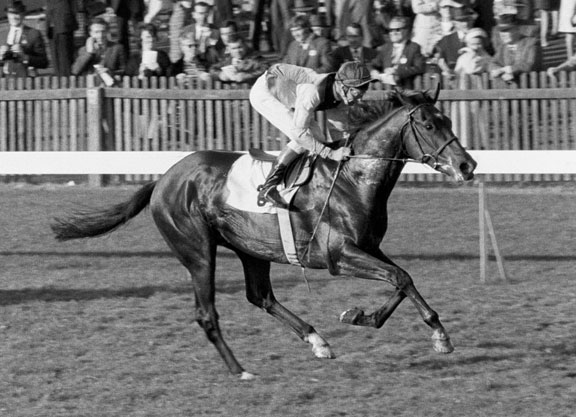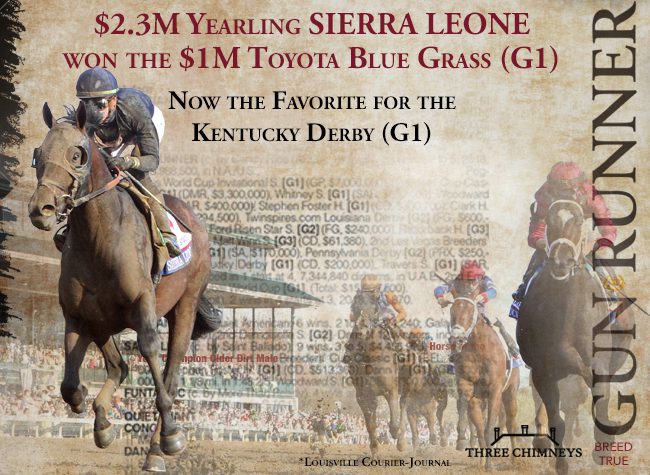By John Berry
We always begin a new year full of optimism for the months to come. Within racing, we all hope to be lucky enough to see another superstar, generally focusing on the horse who has just established himself as the champion 2-year-old. In 2020 we are naturally all anticipating the Classic campaign of Pinatubo (Ire) (Shamardal). Will he delight or disappoint? Only time will tell; but, however well he does, he will be hard-pressed to emulate the achievements of the colt on whom racing fans were pinning their hopes 50 years ago. Nijinsky (Northern Dancer) had ended 1969 as the unbeaten champion 2-year-old, but the best was still to come. Nijinsky's Triple Crown campaign of 1970 remains the stuff of legend, and the mighty bay horse still ranks as one of the most notable sires of the modern era.
A member of the second crop of the 1964 Kentucky Derby, Preakness S. and Queen's Plate winner Northern Dancer (Nearctic), Nijinsky could well have done his racing in America but for the genius of Vincent O'Brien. Dispatched by Charles Engelhard to Windfields Farm in Ontario to inspect E. P. Taylor's yearlings, O'Brien reported that one stood out: a colt by the totally unproven sire Northern Dancer from the 1962 Queen's Plate and Canadian Oaks heroine Flaming Page (Bull Page). Nijinsky was duly purchased for Engelhard at the Windfields sale (for $84,000, a new record price for a yearling in Canada) and flown across the Atlantic to join O'Brien's string at Ballydoyle in County Tipperary.
Despite being very big, Nijinsky came to hand quickly, his natural speed and sublime talent shining through from an early stage. Ridden by O'Brien's stable jockey Liam Ward, he ran at The Curragh four times in the summer of 1969 and won easily each time, taking the Erne S., the Railway S., the Anglesey S. and the Beresford S. He then flew over to England in the autumn and strolled home in the Dewhurst S. at Newmarket, ridden for the first time by Lester Piggott (who was to ride him in all his races outside Ireland, with Ward on board in all his domestic appearances). The opposition was not strong but he won so easily that he was allotted top weight in the Free Handicap, two pounds above Observer Gold Cup (now G1 Vertem Futurity S.) winner Approval (GB) (Alcide {GB}) and four pounds above July S., Middle Park S. and Cornwallis S. winner Huntercombe (GB) (Derring Do {GB}).
Nijinsky duly started 1970 carrying a mighty burden of expectation but he went on to exceed even the highest of hopes. The British Triple Crown (ie. the 2000 Guineas over a mile at Newmarket in May, the Derby over 12 furlongs at Epsom in June and the St Leger over 14.5 furlongs at Doncaster in September) had not been won since Frank Butters had prepared HH Aga Khan III's home-bred Bahram (GB) (Blandford {Ire}) to win the three races in 1935. Nijinsky completed the treble with ease, taking his record to 11 from 11, as well as strolling home in two other championship races: the Irish Sweeps Derby at The Curragh and the King George VI And Queen Elizabeth S. at Ascot, where he gave a virtuoso demonstration of his trademark instant acceleration by sweeping past the previous year's Derby winner Blakeney (GB) (Hethersett {GB}) like a Formula 1 car overtaking a jeep.
Nijinsky was inexplicably beaten on his final two starts by Sassafras (Fr) (Sheshoon {GB}) in the Prix de l'Arc de Triomphe at Longchamp and by Lorenzaccio (GB) (Klairon {Fr}) in the Champion S. at Newmarket (dig out the film of the Arc and, however many times you watch it, you still won't be able to work out how he failed to win) but that didn't matter: as Timeform put it, “Nijinsky made the racing year: such were his feats that he dominated it from start to finish, and for the best part of the season he towered over the opposition.” Besides, as 'Bull' Hancock, a rock of composure amid the maelstrom of disappointment, put it so philosophically at Longchamp, “We all know that if you run them often enough, they'll get beaten eventually.”
Hancock was more entitled than most to take Nijinsky's defeat badly because he had already sealed the deal to secure the colt for stud duties at Claiborne. However, he never had any reason to regret that decision, either on that day or at any time afterwards. Nijinsky went on to prove himself an outstanding stallion, consistently successful from the outset up to his death, aged 25, in 1992, and beyond. If 1970 was his annus mirabilis, then 1986 wasn't far behind. It wasn't just that he ended the season as champion sire of Great Britain and Ireland. Even better was that he had became the only stallion in history to sire the winners of the Derby (Shahrastani, beating Dancing Brave at Epsom prior to following up in the Irish Derby at The Curragh) and the Kentucky Derby (Ferdinand, who went on to land the GI Breeders' Cup Classic and secure Horse of the Year honours the following year) in the same season.
Nijinsky's other sires' championships came in the U.S., where he was champion broodmare sire in both 1993 and 1994. In the former year his best earner was the multiple Grade I-winning racemare Flawlessly (Affirmed), who won the second of her two Eclipse awards as champion female turf horse that season. In 1994 Nijinsky's most successful grandchild was the GI Jockey Club Gold Cup and GI Whitney H. winner Colonial Affair (Pleasant Colony).
Shahrastani was the second of the three Derby winners sired by Nijinsky, following Golden Fleece in 1982 and preceding Lammtarra in 1995. Remarkably both of these horses did something which their father couldn't manage: they both retired unbeaten, with Lammtarra's other victories including the G1 King George VI And Queen Elizabeth S. and the G1 Prix de l'Arc de Triomphe. Nijinksy's other European Classic winners were Shadeed (G1 2000 Guineas), King's Lake (G1 Irish 2000 Guineas), Caerleon (G1 Prix du Jockey-Club), Green Dancer (G1 Poule d'Essai des Poulains), Caucasus (G1 Irish St Leger) and Niniski (G1 Irish St Leger and G1 Prix Royal-Oak). His other stars included Ile De Bourbon (G1 King George VI And Queen Elizabeth S.), Solford (G1 Eclipse S.), Royal Academy (G1 July Cup, G1 Breeders' Cup Mile), Dancing Spree (G1 Breeders' Cup Sprint), Quiet Fling (G1 Coronation Cup) and Sky Classic (G1 Rothmans Canadian International, G1 Turf Classic Invitational).
Nijinsky's influence has extended well beyond the first generation. Many of his sons and grandsons became significant stallions. Caerleon was champion sire of Great Britain and Ireland in both 1988 and 1991, when his son Generous (Ire) posted outstanding victories in the G1 Derby, G1 Irish Derby and G1 King George VI And Queen Elizabeth S. In that latter year Green Dancer was champion sire in France, largely thanks to the G1 Prix du Jockey Club and G1 Prix de l'Arc de Triomphe victories of Suave Dancer. Ile De Bourbon sired the 1988 Derby winner Kahyasi (Ire). Shadeed sired two winners of the G1 1000 Guineas, Sayyedati and Shadayid, as well as the 1992 Queen's Plate winner Alydeed. Niniski sired the champions and top-class stallions Lomitas (GB) and Hernando (Fr).
Furthermore, several lesser-performed sons of Nijinsky sired superstars Down Under. Whisky Road sired the international champion Strawberry Road (Aus) and the 1981 G1 Melbourne Cup winner Just A Dash (Aus); Yeats sired the 1988 G1 Cox Plate winner Our Poetic Prince (NZ); Serheed sired the 2001 and 2002 G1 Cox Plate winner Northerly (Aus). The Royal Academy stallion Bel Esprit (Aus) sired the international champion sprinter Black Caviar (Aus); another Royal Academy stallion, Ihtiram (Ire), sired the international champion sprinter Miss Andretti (Aus).
Nijinsky's greatest legacy, though, is less specific. Vincent O'Brien had been one of the world's most successful trainers since the 1950s, which is how he had come to be training for American tycoon Charles Engelhard (who was reputed to be the inspiration for Auric Goldfinger, the central character in Ian Fleming's James Bond novel and movie 'Goldfinger') in the first place. However, he is best remembered for the success which he enjoyed from Nijinsky onwards with sons of Northern Dancer (and, in turn, of Nijinsky) thus ensuring the worldwide dominance both of the Northern Dancer sire-line and of Coolmore Stud. Had Vincent O'Brien not stumbled upon the young Nijinsky in the Windfields paddocks in the summer of 1968, would he have invested so heavily in Northern Dancer's stock in the years that followed? Would Coolmore have gained the position of worldwide eminence which it now enjoys? Would Northern Dancer have become the breed-shaper that he has proved to be? Would Sadler's Wells and Galileo have even been born?
That's all academic. What we do know is that, 50 years on, the memory of Nijinsky's brilliance still burns brightly in the collective racing memory. Perhaps his greatest epitaph is the one which keeps coming from the lips of disgruntled punters who, believing that the jockey has given their beaten selection too much to do, still come out with the refrain, “What was he playing at? He must have thought he was on Nijinsky!” Compliments don't come any higher than that.
HOOFNOTE: There is no better way to savour the beauty and majesty of Nijinsky than by watching the documentary 'A Horse Called Nijinsky', memorably narrated by Orson Welles, which was made by Jo Durden-Smith to honour him at the end of his Triple Crown-winning season in 1970.
Not a subscriber? Click here to sign up for the daily PDF or alerts.






